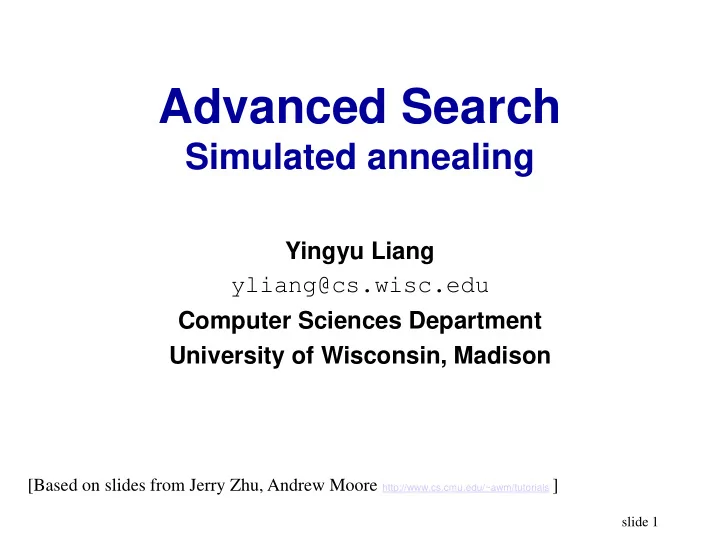

Advanced Search Simulated annealing Yingyu Liang yliang@cs.wisc.edu Computer Sciences Department University of Wisconsin, Madison [Based on slides from Jerry Zhu, Andrew Moore http://www.cs.cmu.edu/~awm/tutorials ] slide 1
2. SIMULATED ANNEALING slide 2
Simulated Annealing anneal • To subject (glass or metal) to a process of heating and slow cooling in order to toughen and reduce brittleness. slide 3
Simulated Annealing 1. Pick initial state s 2. Randomly pick t in neighbors( s ) 3. IF f ( t ) better THEN accept s t . 4. ELSE /* t is worse than s */ accept s t with a small probability 5. 6. GOTO 2 until bored. slide 4
Simulated Annealing 1. Pick initial state s 2. Randomly pick t in neighbors( s ) 3. IF f ( t ) better THEN accept s t . 4. ELSE /* t is worse than s */ accept s t with a small probability 5. 6. GOTO 2 until bored. What are the two key differences from Hill-Climbing? slide 5
Simulated Annealing 1. Pick initial state s 2. Randomly pick t in neighbors( s ) 3. IF f ( t ) better THEN accept s t . 4. ELSE /* t is worse than s */ accept s t with a small probability 5. 6. GOTO 2 until bored. How to choose the small probability? idea 1: p = 0.1 slide 6
Simulated Annealing 1. Pick initial state s 2. Randomly pick t in neighbors( s ) 3. IF f ( t ) better THEN accept s t . 4. ELSE /* t is worse than s */ accept s t with a small probability 5. 6. GOTO 2 until bored. How to choose the small probability? idea 1: p = 0.1 What’s the drawback? Hint: consider the case when we are at the global optimum slide 7
Simulated Annealing 1. Pick initial state s 2. Randomly pick t in neighbors( s ) 3. IF f ( t ) better THEN accept s t . 4. ELSE /* t is worse than s */ accept s t with a small probability 5. 6. GOTO 2 until bored. How to choose the small probability? idea 1: p = 0.1 idea 2: p decreases with time slide 8
Simulated Annealing 1. Pick initial state s 2. Randomly pick t in neighbors( s ) 3. IF f ( t ) better THEN accept s t . 4. ELSE /* t is worse than s */ accept s t with a small probability 5. 6. GOTO 2 until bored. How to choose the small probability? idea 1: p = 0.1 idea 2: p decreases with time idea 3: p decreases with time, also as the ‘badness’ | f ( s )- f ( t )| increases slide 9
Simulated Annealing • If f ( t ) better than f ( s ), always accept t • Otherwise, accept t with probability Boltzmann | ( ) ( ) | f s f t exp distribution Temp slide 10
Simulated Annealing • If f ( t ) better than f ( s ), always accept t • Otherwise, accept t with probability Boltzmann | ( ) ( ) | f s f t exp distribution Temp • Temp is a temperature parameter that ‘cools’ (anneals) over time, e.g. Temp Temp * 0.9 which gives Temp=(T 0 ) #iteration slide 11
Simulated Annealing • If f ( t ) better than f ( s ), always accept t • Otherwise, accept t with probability Boltzmann | ( ) ( ) | f s f t exp distribution Temp • Temp is a temperature parameter that ‘cools’ (anneals) over time, e.g. Temp Temp * 0.9 which gives Temp=(T 0 ) #iteration ▪ High temperature: almost always accept any t ▪ Low temperature: first-choice hill climbing slide 12
Simulated Annealing • If f ( t ) better than f ( s ), always accept t • Otherwise, accept t with probability Boltzmann | ( ) ( ) | f s f t exp distribution Temp • Temp is a temperature parameter that ‘cools’ (anneals) over time, e.g. Temp Temp * 0.9 which gives Temp=(T 0 ) #iteration ▪ High temperature: almost always accept any t ▪ Low temperature: first-choice hill climbing • If the ‘badness’ (formally known as energy difference) | f ( s )- f ( t )| is large, the probability is small. slide 13
SA algorithm // assuming we want to maximize f() current = Initial-State(problem) for t = 1 to do T = Schedule(t) ; // T is the current temperature, which is monotonically decreasing with t if T=0 then return current ; //halt when temperature = 0 next = Select-Random-Successor-State(current) deltaE = f(next) - f(current) ; // If positive, next is better than current. Otherwise, next is worse than current. if deltaE > 0 then current = next ; // always move to a better state else current = next with probability p = exp(deltaE / T) ; // as T 0, p 0; as deltaE - , p 0 end slide 14
Simulated Annealing issues • Easy to implement. • Intuitive: Proposed by Metropolis in 1953 based on the analogy that alloys manage to find a near global minimum energy state, when annealed slowly. slide 15
Simulated Annealing issues • Cooling scheme important • Neighborhood design is the real ingenuity, not the decision to use simulated annealing. • Not much to say theoretically ▪ With infinitely slow cooling rate, finds global optimum with probability 1. • Try hill-climbing with random restarts first! slide 16
Recommend
More recommend